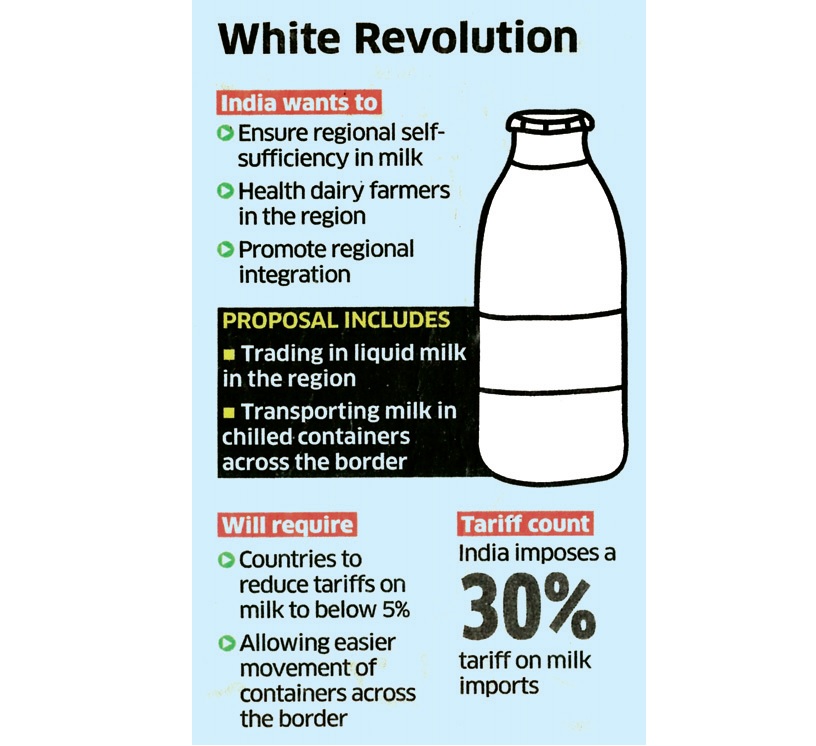India has drawn up a plan to create a ‘white grid’ or a milk grid in South Asia that will seek to replicate the success of the ‘white revolution’ launched in the 1970s, two government officials familiar with the development told ET. The proposed regional milk grid will benefit dairy farmers in the region by linking milk surplus countries with the deficit ones, they said. New Delhi will also push for tariff reduction to less than 5% under the South Asia Free Trade Area (SAFTA) agreement to facilitate the grid. “Many of our neighbours are importing a lot of milk powder. We are suggesting that just like the energy grid, let there be a milk grid to facilitate liquid milk trade between these countries so that the dairy farmers of these countries benefit instead of the countries outside the region, sending milk powder,“ said a commerce department official. The move is expected to benefit South Asian Association of Regional Cooperation (SAARC) countries like Bangladesh, Bhutan and Sri Lanka, which import milk from outside the region to meet their demand. SAARC includes India, Pakistan, Afghanistan, Nepal, Maldives, Bangladesh, Bhutan and Sri Lanka. India’s exports to SAARC nations registered 17.09% growth in 2014-15 at $20.4 billion. A government official said India discussed the white grid idea with Bangladesh at bilateral level talks a few months ago. “Bangladesh has agreed to do some amount of work for freer movement of milk. Since the per capita consumption of milk in South Asia is much less compared to other parts of the world, this is one way to grow the market and create income for dairy farmers,“ said the official. India’s multi-modal transport pact with three SAARC countries – Bhutan, Bangladesh and Nepal – last week would act as a
facilitator for the plan as it will enable seamless transit of passenger and cargo vehicles among these countries. The grid will essentially help dampen milk inflation in the region. “Just like energy, demand peaks at different points of time. This is an effort to dampen that milk inflation in the region and also reward dairy farmers in the region,“ the government official said. SAARC countries had agreed to a South Asia electricity grid to trade power within the eight nations at the summit in Kathmandu last year. “If we can agree to keep tariff below 5%, as is the SAFTA aim, it will become easier to do trade,“ said another official. Nisha Taneja, professor at economic policy think tank at the Indian Council for Research on International Economic Relations (ICRIER), said, “It is a good idea. But there should a phase two that includes transfer of technology and building their supply capabilities, so there is enough milk for the region. The focus must be to pool in generation and distribution in order to make the idea more sustainable and beneficial to all countries.“ India should announce zero tariff on milk for the South Asia region to begin with, Taneja said. The trade in dairy products within the SAARC countries is considerably low. Currently most SAARC countries, including India, have milk in their sensitive list, on which concessional tariff does not apply. India has over 30% tariff on milk imports, while the ceiling rate, up to which India can increase tariff s on dairy ranges between 40% and 100%. It allows import of skimmed milk powder at lower duty under a special window. India is the world’s top milk producer with a global share of about 18%. However, while the milk demand has been rising by 6-8% per annum in India, the supply is growing by just 4-5% per annum. The country’s top milk brand Amul’s exports slumped 53% to `250 crore in 2014-15 and the firm plans to focus on SAARC countries in the coming years. Gujarat Cooperative Milk Marketing Federation, an aggregate of 17 milk cooperatives that owns Amul brand, processes 154 lakh litres of milk procured from Gujarat and other states daily.
(Source: The Economic Times, Mumbai, January 24, 2015)
Disclaimer: The information provided within this publication / eBook/ content is for general informational purposes only. While we try to keep the information up-to-date and correct, there are no representations or warranties, express or implied, about the completeness, accuracy, reliability, suitability or availability with respect to the information, products, services, or related graphics contained in this publication / eBook/ content for any purpose. Any use of this information is at your own risk.
 Youth
Youth
 Women
Women
 Research for Ishrae
Research for Ishrae







